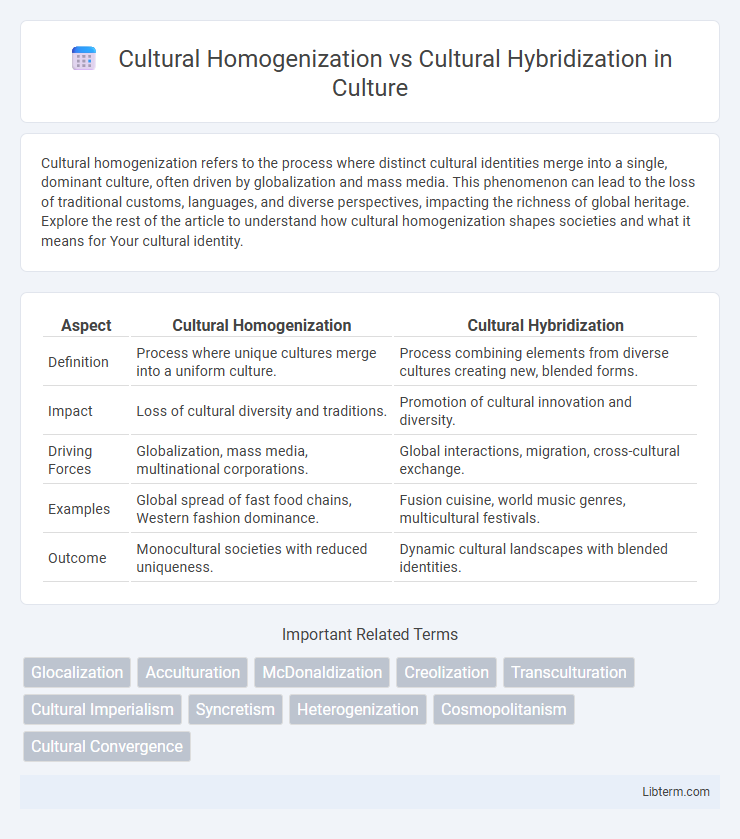Cultural homogenization refers to the process where distinct cultural identities merge into a single, dominant culture, often driven by globalization and mass media. This phenomenon can lead to the loss of traditional customs, languages, and diverse perspectives, impacting the richness of global heritage. Explore the rest of the article to understand how cultural homogenization shapes societies and what it means for Your cultural identity.
Table of Comparison
| Aspect | Cultural Homogenization | Cultural Hybridization |
|---|---|---|
| Definition | Process where unique cultures merge into a uniform culture. | Process combining elements from diverse cultures creating new, blended forms. |
| Impact | Loss of cultural diversity and traditions. | Promotion of cultural innovation and diversity. |
| Driving Forces | Globalization, mass media, multinational corporations. | Global interactions, migration, cross-cultural exchange. |
| Examples | Global spread of fast food chains, Western fashion dominance. | Fusion cuisine, world music genres, multicultural festivals. |
| Outcome | Monocultural societies with reduced uniqueness. | Dynamic cultural landscapes with blended identities. |
Defining Cultural Homogenization
Cultural homogenization refers to the process by which local cultures are transformed or absorbed by dominant external influences, leading to a reduction in cultural diversity and the global spread of uniform practices, values, and products. This phenomenon is often driven by globalization, mass media, and multinational corporations, which promote standardized cultural expressions at the expense of indigenous customs and traditions. The result is a more uniform global culture where distinct cultural identities become less pronounced, raising concerns about cultural loss and diminished social diversity.
Understanding Cultural Hybridization
Cultural hybridization refers to the dynamic process where distinct cultural elements merge to create new, hybrid cultural forms that reflect diverse influences and innovations. This phenomenon promotes cultural exchange and adaptation rather than uniformity, fostering unique identities within globalized societies. Understanding cultural hybridization highlights how globalization drives cultural diversity through the blending of languages, traditions, and social practices.
Historical Contexts of Cultural Exchange
Cultural homogenization often results from historical processes like colonization and globalization, where dominant cultures impose their values, languages, and practices on others, leading to a reduction in cultural diversity. In contrast, cultural hybridization emerges through sustained historical interactions such as trade along the Silk Road, migration, and imperial expansions, creating new, syncretic cultural forms that blend elements from multiple traditions. These historical contexts of cultural exchange highlight the dynamic tension between the forces of cultural uniformity and the creative fusion of diverse cultural influences.
Globalization and Its Impact on Cultures
Globalization accelerates cultural homogenization by spreading dominant cultural traits, often leading to the erosion of local traditions and languages. Conversely, cultural hybridization emerges as diverse cultures interact, blending elements to create new, syncretic practices that reflect global interconnectedness. This dynamic interplay highlights globalization's dual impact: diminishing cultural uniqueness while fostering innovative cultural fusion.
Media Influence: Homogenizing or Hybridizing?
Media plays a pivotal role in shaping cultural identities by both homogenizing and hybridizing global cultures. Mass media often promotes cultural homogenization by disseminating dominant cultural norms, primarily from Western societies, leading to uniform consumer behaviors and shared global references. Conversely, media also facilitates cultural hybridization by enabling the fusion of diverse cultural elements, creating new, syncretic cultures through localized adaptations and cross-cultural exchanges.
Case Studies: Westernization in Non-Western Societies
Westernization in non-Western societies demonstrates cultural homogenization through the widespread adoption of Western consumer brands, media, and lifestyles, diminishing indigenous cultural distinctions. However, cultural hybridization emerges as local communities adapt Western influences, blending them with traditional practices to create unique, syncretic identities, as seen in Japan's fusion of Western fashion with traditional kimono styles. Case studies in India reveal Bollywood's integration of Western cinematic techniques with Indian storytelling, exemplifying how hybridization resists homogenization by producing culturally distinct, globally influenced expressions.
Cultural Identity in a Globalized World
Cultural homogenization often threatens cultural identity by promoting uniformity and diminishing unique traditions, languages, and practices across global societies. In contrast, cultural hybridization fosters the blending of diverse cultural elements, enabling individuals to maintain distinct identities while adapting to global influences. This dynamic interplay shapes cultural identity in a globalized world, balancing preservation with innovation and intercultural exchange.
Resistance and Adaptation: Local Responses to Global Culture
Cultural homogenization often triggers local resistance as communities strive to preserve distinctive traditions and identities against dominant global influences. In contrast, cultural hybridization reflects adaptive responses where local cultures blend global elements with indigenous practices, creating innovative hybrid forms that sustain cultural relevance. These dynamics illustrate how global culture simultaneously challenges and enriches local identities through ongoing negotiation and transformation.
Benefits and Challenges of Hybrid Cultures
Cultural hybridization fosters innovation by blending diverse traditions, languages, and practices, enriching social identities and promoting intercultural understanding. This fusion enhances creativity in art, cuisine, and technology, driving economic growth and global collaboration. However, challenges include potential loss of distinct cultural identities and tensions arising from unequal power dynamics during cultural exchanges.
The Future of Cultural Diversity
Cultural homogenization, driven by globalization and mass media, threatens to erode unique traditions and languages worldwide, leading to a more uniform global culture. In contrast, cultural hybridization fosters the blending of diverse customs, creating dynamic new cultural expressions that preserve diversity while adapting to modern contexts. The future of cultural diversity depends on balancing these forces by promoting inclusive policies that support both the protection of heritage and the innovative fusion of cultural identities.
Cultural Homogenization Infographic

 libterm.com
libterm.com